Abstract
Tetracycline antibiotics are widely used, but their resistance to degradation and persistence in the environment pose a potential risk of inducing antibiotic resistance, creating significant threats to both the environment and human health. This study established a laccase–mediator system (LMS) using natural green tea polyphenols (GTPs) as mediators for efficient tetracycline degradation. Through analyzing the main GTP components and optimizing the reaction conditions, the degradation efficiency of the system was evaluated. The experimental results indicated that, among the various tea polyphenol components, epicatechin gallate (ECG) contributed the most significantly to the degradation efficiency. Under optimized conditions, the Lac-ECG system degraded over 98% of tetracycline within 3–4 min. Further optimization of the Lac-GTP system allowed us to identify the following optimal conditions: a GTP concentration of 1.0 mmol/L, laccase concentration of 1.0 mg/mL, pH of 6.0, and temperature of 25 °C. Under these conditions, a degradation rate of 95.07% was attained within 5 min, outperforming a system using the synthetic mediator ABTS. Additionally, metal ions such as Ca2+, Mg2+, Cu2+, Fe3+, Fe2+, and Ni2+ were found to enhance the degradation process, while Mn2+ and Hg2+ exhibited inhibitory effects. Antibacterial activity tests revealed that the degradation products completely lost their antimicrobial activity, demonstrating effective detoxification of tetracycline. In conclusion, the tea polyphenol-based laccase–mediator system developed in this study exhibits high efficiency, cost-effectiveness, and environmental friendliness, offering a promising strategy for the remediation of tetracycline-contaminated environments.
1. Introduction
Tetracyclines are a class of antibiotics applied widely and early in the treatment process [1]. Due to their broad-spectrum activity [2], reasonable cost [3], high quality [4], and ease of oral absorption [5], among other characteristics, they are extensively used in clinical medicine, animal husbandry, aquaculture, and other fields [6,7] to treat bacterial infections [8] and prevent [9] and cure disease [10]; they are even used for therapeutic purposes and as growth promoters in animal husbandry [11,12,13]. Reportedly, tetracyclines have become the second most used antibiotics worldwide [14,15,16]. However, due to animals and humans’ poor absorption of tetracyclines [17] and their resistance to degradation [18,19], only a portion of these antibiotics is metabolized [20]. The rest is easily excreted in urine as the parent compound or intermediate metabolites [21,22,23], leading to tetracyclines’ widespread presence in soil, water bodies, and sediments [22,24] and causing severe environmental pollution [25,26,27]. The misuse of tetracyclines disrupts fundamental microbial community structures and promotes the development of antibiotic-resistant bacteria (ARB) and the proliferation of antibiotic resistance genes (ARGs) [28], thereby significantly enriching the resistance of bacterial populations [29,30] and posing potential threats to ecosystems and human health [3,31,32]. Therefore, researching the ecological risks of tetracycline antibiotics and developing efficient, environmentally friendly degradation methods are key to addressing tetracycline antibiotic pollution.
Currently, a variety of methods are employed to degrade tetracycline, including physical, chemical, and biological approaches [33,34,35]. Physical methods primarily rely on adsorption and membrane treatment technologies. The main chemical methods include photocatalytic degradation [18], advanced oxidation processes [36], and electrochemical techniques. Biological methods mostly involve microbial treatment and oxidoreductase-mediated degradation. Enzymatic biodegradation offers high specificity, rapid reaction rates, flexible operating conditions, and effective performance under harsh environmental conditions and does not require nutrient supplementation [37]. Due to its environmentally friendly nature and because it does not cause secondary pollution, it has attracted widespread attention [38].
For instance, a natural laccase with strong cold adaptability and thermal stability was isolated from the white-rot fungus Pycnoporus sp. SYBC-L10 and purified. At a laccase concentration of 10.0 U/mL and an ABTS concentration of 1.0 mmol/L, tetracycline was effectively degraded under static incubation conditions at 0 °C (pH 6.0) [39]. Similarly, Al-Dhabi et al. extracted a tetracycline-degrading bacterium from municipal sludge and purified a manganese peroxidase for tetracycline degradation. Their results demonstrated that the highest degradation rate, 87 mg/L, was reached with an initial tetracycline concentration of 143.75 mg/L, a pH of 6.94, and an inoculation volume of 8.04% [40].
Currently, the main enzymes used for tetracycline degradation include lignin peroxidase, manganese peroxidase, and laccase. These enzymes have demonstrated good efficacy in degrading tetracycline antibiotics.
Laccase is a multi-copper phenol oxidoreductase, with phenolic substances being its natural substrates [41,42,43]. It possesses a strong oxidative capacity and can catalyze the oxidation of various substrates. Numerous studies have shown that a laccase–mediator system can degrade antibiotics. For instance, Suda et al. [44] treated TC, CTC, DC, and OTC with laccase from the white-rot fungus Trametes versicolor in the presence of the redox mediator 1-hydroxybenzotriazole (HBT). The results showed that DC and CTC were completely eliminated within 15 min, while TC and OTC were completely eliminated within 1 h. Lou et al. degraded sulfonamides in aquaculture wastewater using a laccase–syringaldehyde mediator system with a temperature of 30 °C, pH of 5.32 ± 0.05, and laccase concentration of 0.5 mL/L, achieving a degradation rate of 91.07% [45]. Jinga et al. utilized laccase and the stable organic nitroxyl radical TEMPO to remove doxorubicin from wastewater and polluted water. The results indicated that the degradation rate could reach 100% after 24 h [46]. Laccase holds potential application value in tetracycline degradation.
China, in which tea originated, has a long history of tea cultivation and consumption and remains one of the world’s major tea producers [47]. Tea leaves are rich in green tea polyphenols (GTPs), which mainly consist of catechins, flavonoids, anthocyanins, and phenolic acids. Notably, green tea contains the highest GTP concentration, reaching 20–30%, making it an excellent natural antioxidant [48]. As a mixture of polyphenolic compounds, GTPs exhibit characteristics such as abundant phenolic hydroxyl groups (–OH), small molecular size, good water solubility, and high free radical stability. These properties render GTPs a highly promising natural mediator for laccase systems [49]. Furthermore, due to their wide availability and straightforward preparation process, GTPs demonstrate significant economic and environmental advantages over synthetic mediators. Compared to synthetic mediators, natural mediators like GTPs offer greater safety, lower cost, reduced toxicity, better environmental compatibility, and superior renewability. They can also be rapidly oxidized by laccase, making them more suitable for practical applications [50].
This study established a Lac–mediator system using natural tea polyphenols as the mediator for tetracycline degradation. The degradation rate was improved by optimizing conditions such as the GTP concentration, enzyme concentration, pH, temperature, and metal ions. The tea polyphenol components were analyzed to identify which was acting as the key mediator. Furthermore, the antibacterial activity of the tetracycline degradation products was analyzed.
2. Results and Discussion
2.1. Optimization of Tetracycline Degradation Conditions with Lac–Mediator System
2.1.1. Effect of GTP Concentration
As shown in Figure 1, the concentration of the GTPs significantly influenced the tetracycline degradation efficiency of the Lac-GTP system. When the GTP concentration increased from 0 mmol/L to 0.5 mmol/L, the tetracycline degradation rate markedly improved. However, as the concentration continued to rise from 0.5 mmol/L to 1.0 mmol/L, the rate of the increase in the degradation efficiency slowed considerably. Further increasing the concentration from 1.0 mmol/L to 2.0 mmol/L resulted in the stabilization of the degradation rate, which reached 99.32% at a GTP concentration of 2.0 mmol/L. These findings indicate that relatively higher mediator concentrations are beneficial for tetracycline removal. Considering both the removal efficiency and economic cost, an optimal GTP working concentration of 1.0 mmol/L is recommended.
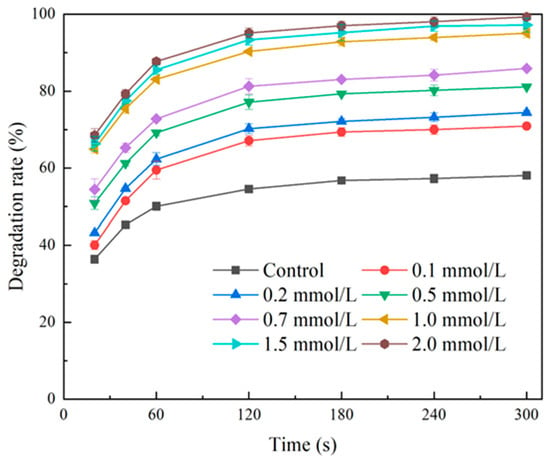
Figure 1.
Effect of GTP concentration on TC removal using Lac-GTP system (tetracycline concentration: 50 mg/L; laccase concentration: 1 mg/mL; pH: 6.0; temperature: 25 °C; reaction time: 0–300 s; GTP concentration gradient: 0, 0.25, 0.5, 1.0, 1.5, 2.0 mmol/L).
This observation is consistent with previous studies. For instance, research investigating the degradation of organic pollutants using syringaldehyde (SA) and 1-hydroxybenzotriazole (HBT) at concentrations of 0.1, 0.5, and 1 mM demonstrated that high mediator concentrations can lead to the formation of free radicals in the enzyme–mediator system, inhibiting enzymatic activity [51].
2.1.2. Effect of Laccase Concentration
The enzyme dosage is a critical factor affecting the degradation efficiency in bioremediation processes. Generally, the degradation efficiency increases with higher enzyme concentrations. Al-Dhabi et al. [40] reported the degradation of tetracycline using manganese peroxidase (MnP) derived from Bacillus velezensis. They found that a higher degradation efficiency was achieved at an enzyme dosage of 7% (w/v). Similarly, Wen et al. [51] demonstrated that the rate of tetracycline degradation using purified MnP significantly increased with a higher enzyme-to-substrate ratio, reaching a saturation point at an enzyme activity of 2.0 U/mg, with a maximum degradation rate of approximately 92% [52].
As shown in Figure 2, after a 5-min reaction at 25.0 °C and pH 6.0, the tetracycline degradation rates of the Lac–mediator system reached 95.07% and 100% at laccase concentrations of 1.0 mg/mL and 2.0 mg/mL, respectively. Considering both the degradation performance and economic cost, an optimal laccase dosage of 1.0 mg/mL is recommended.
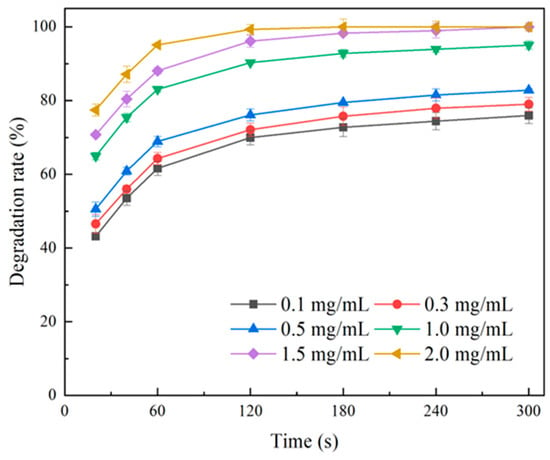
Figure 2.
Effect of laccase concentration on TC removal using Lac-GTP system (tetracycline concentration: 50 mg/L; GTP concentration: 1 mmol/L; pH: 6.0; temperature: 25 °C; reaction time: 0–300 s; laccase concentration gradient: 0.1, 0.3, 0.5, 1.0, 1.5, 2.0 mg/mL).
2.1.3. Effect of pH
As shown in Figure 3, the degradation rate of tetracycline increased significantly within a pH range of 3.0 to 5.0. No notable change in the degradation efficiency was observed when the pH was raised from 5.0 to 6.0, whereas a significant decrease occurred at pH 7.0. Therefore, at 25 °C, the optimal pH range for this system was determined to be 5.0–6.0.
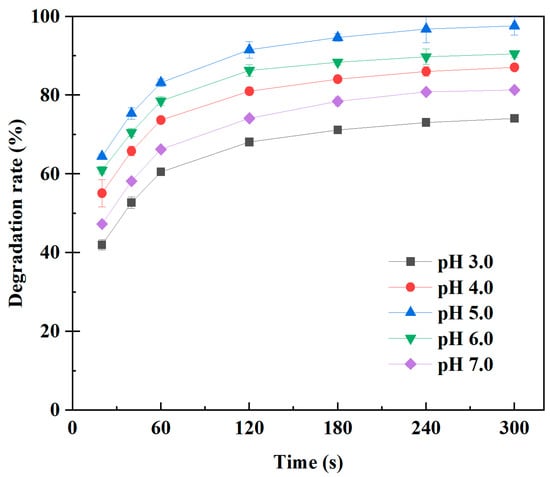
Figure 3.
Effect of pH on TC removal using Lac-GTP system. (Tetracycline concentration: 50 mg/L; GTP concentration: 1 mmol/L; laccase concentration: 1 mg/mL; temperature: 25 °C; reaction time: 0–300 s; pH gradient: 3.0, 4.0, 5.0, 6.0, 7.0).
Previous studies have indicated that Lac-SA and Lac-HBT systems exhibit optimal pH ranges of 6.0–7.0 for the degradation of sulfonamide antibiotics [51,52]. This discrepancy may be attributed to variations in the optimal pH among laccases derived from different microbial sources. Enzyme activity is often inhibited when the reaction pH deviates from the optimum, and most enzymes function effectively in a slightly acidic to neutral pH range [53].
2.1.4. Effect of Temperature
The temperature is a critical environmental factor affecting the function of both intracellular and extracellular microbial enzymes, regulating their catalytic activity. As proteins, enzymes are particularly sensitive to high temperatures, which may cause conformational changes or denaturation, leading to a loss of catalytic function [37]. Different types of enzymes exhibit distinct optimal temperature ranges, and even the same enzyme derived from different sources may show significant variations in its temperature optimum. For instance, lipases and peroxidases typically have optimal temperatures within the range of 15–30 °C [54]. According to Weng et al., the temperature significantly influences the efficiency of sulfonamide antibiotic degradation by a laccase–mediator system. Laccase derived from the Perenniporia strain TFRI 707 removed over 90% of sulfonamide antibiotics at temperatures below 60 °C [55].
As shown in Figure 4, at pH 6.0, the tetracycline degradation rate increased markedly as the temperature rose from 10 °C to 25 °C. The rate of increase slowed between 25 °C and 50 °C, and a slight decline in the degradation efficiency was observed at 60 °C. Considering the degradation performance, energy consumption, and practical applicability, a reaction temperature of 25 °C is recommended.
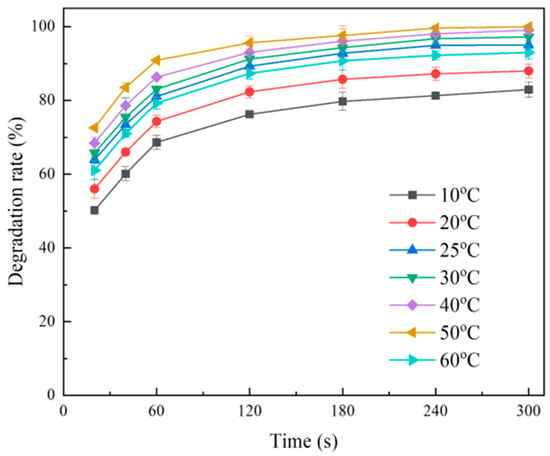
Figure 4.
Effect of temperature on TC removal using Lac-GTP system (tetracycline concentration: 50 mg/L; GTP concentration: 1 mmol/L; laccase concentration: 1 mg/mL; pH: 6.0; reaction time: 0–300 s; temperature gradient: 10 °C, 25 °C, 37 °C, 50 °C, 60 °C).
2.1.5. Effect of Different Metal Ions
Metal ions in solution may significantly influence the removal of tetracycline by a laccase–mediator system. To clarify the specific role of various metal ions in this process, their effects on tetracycline degradation by the Lac-GTP system were systematically evaluated at a laccase concentration of 0.5 mg/mL. As shown in Figure 5, Mg2+, Cu2+, Ca2+, Fe3+, Fe2+, and Ni2+ enhanced tetracycline degradation within the tested concentration range, whereas Mn2+ and Hg2+ inhibited the reaction. This inhibitory effect may be attributed to the disruption of interactions between laccase, tetracycline, and the mediator (GTPs) by Mn2+ and Hg2+. Na+, K+, and Zn2+ had no significant effect on the degradation process under low-concentration conditions. Under high-concentration conditions, although a weak promoting effect was observed, the effect was not significant. In this study, the reaction system without the addition of the aforementioned exogenous ions was used as the blank control group, and comparisons were made with the blank control to accurately evaluate the impact of these ions on the degradation reaction.
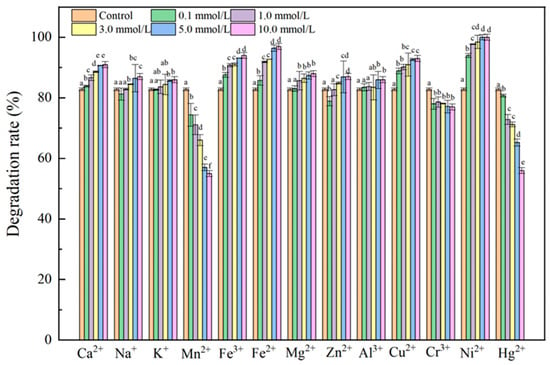
Figure 5.
Effect of metal ions on TC removal using Lac-GTP system (tetracycline concentration: 50 mg/L; GTP concentration: 1 mmol/L; laccase concentration: 0.5 mg/mL; pH: 6.0; temperature: 25 °C; reaction time: 0–300 s; types of metal ions: Ca2+, Mg2+, Cu2+, Fe3+, Fe2+, Ni2+, Mn2+, Hg2+, Na+, K+, Zn2+; concentration range: 0.1–10.0 mmol/L; For each tested ionic group, different letters on the top of column indicate significant differences between means, p < 0.05).
The enhancement of tetracycline removal by Cu2+ can be explained by two possible mechanisms: firstly, metal ions may affect the stability of tetracycline, rendering it more susceptible to enzymatic degradation; secondly, as an essential cofactor in laccase’s active site, an appropriate concentration of Cu2+ can enhance the laccase activity. Furthermore, previous studies have indicated that certain filtered metal species can act as activators of laccase, thereby enhancing its activity and facilitating the efficient degradation of antibiotics [56].
2.2. The Functions of the Tea Polyphenol Components
2.2.1. Main Tea Polyphenol Components
Figure 6 shows the high-performance liquid chromatography (HPLC) profile of a tea polyphenol sample. Owing to the complexity of its components, we selected representative bioactive constituents—gallic acid (GA), epicatechin (EC), epigallocatechin gallate (EGCG), epigallocatechin (EGC), and epicatechin gallate (ECG)—as standards to determine their relative abundances within the tea polyphenols. Figure 7 presents the mass spectra of the main polyphenol components in tea residues, where the identified chromatographic peaks correspond to GA, EC, EGCG, EGC, and ECG, respectively. In the tea polyphenol sample used in this experiment, gallocatechin (GC) and gallocatechin gallate (GCG) were not detected.
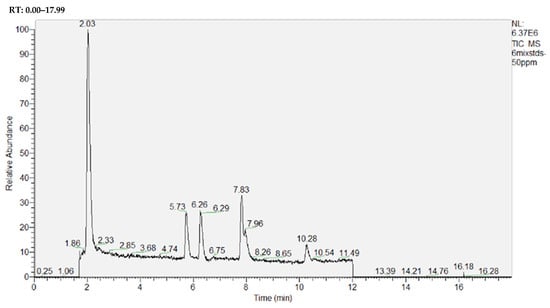
Figure 6.
Liquid chromatography profile of tea polyphenols (time 2.03: GA; time 5.73: EGC; time 6.26: EC; time 7.83: EGCG; time 10.28: ECG).
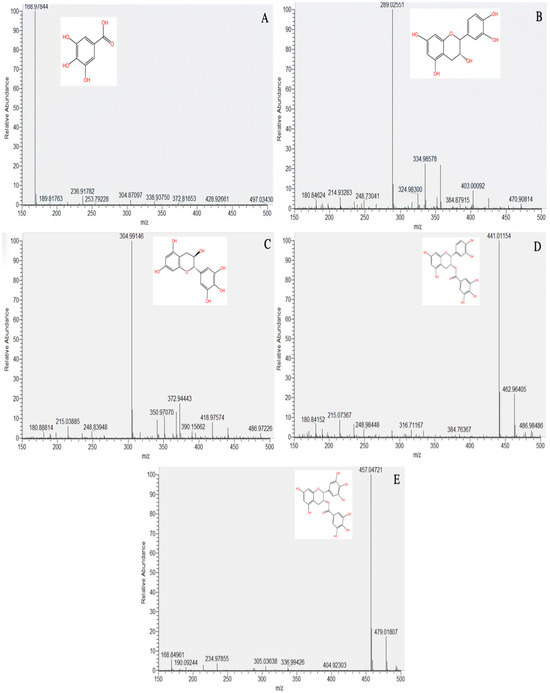
Figure 7.
Mass spectra of main polyphenol components in tea leaves, obtained through LC-MS ((A): GA; (B): EC; (C): EGC; (D): ECG; (E): EGCG).
2.2.2. Mediator’s Effects on Tetracycline Degradation
In this study, major components extracted from tea residues were utilized as laccase mediators to compare their efficacy in tetracycline degradation at concentrations (Table 1) proportional to their abundance in the green tea polyphenol (GTP) extract. As shown in Figure 8, the Lac-EGC system exhibited the highest degradation efficiency, followed by the Lac-ECG system, and then the Lac-GA system. Further analysis of each component’s contribution to the increment in tetracycline degradation revealed that ECG’s was the highest. Consequently, ECG was selected as the mediator in subsequent experiments on tetracycline degradation using the Lac-ECG system.

Table 1.
Contents of main tea polyphenol components and their effects on TC degradation.
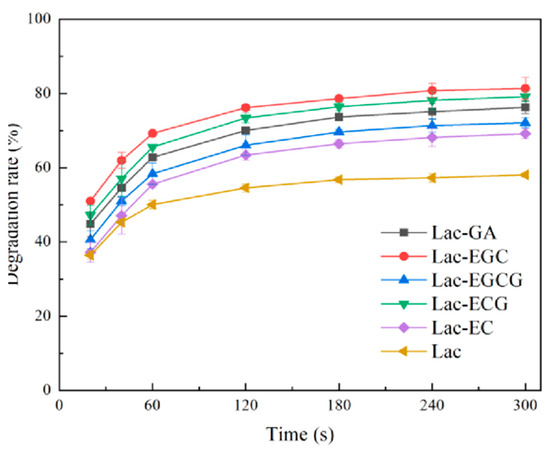
Figure 8.
Effect on tetracycline degradation of using main tea polyphenol components in LMS (tetracycline concentration: 50 mg/L; laccase concentration: 1 mg/mL; pH: 6.0; temperature: 25 °C; reaction time: 0–300 s; GA 77.11 μmol/L, EC 8.03 μmol/L, EGC 31.03 μmol/L, EGCG 2.03 μmol/L, ECG 3.02 μmol/L; the laccase-only system was used as the control).
As illustrated in Figure 9, the concentration of ECG exhibited a significant influence on the tetracycline degradation efficiency within the Lac-ECG system. As the ECG concentration increased from 0 mmol/L to 1.0 mmol/L, the degradation rate of tetracycline rose progressively. At 1.0 mmol/L ECG, the degradation rate exceeded 98% within 3–4 min and near-complete removal was achieved after 5 min. However, a further increase in the ECG concentration from 1.0 mmol/L to 1.5 mmol/L did not lead to a notable enhancement in the degradation efficiency. A laccase–mediator system (LMS) containing only ECG demonstrated superior tetracycline degradation performance compared to one containing multiple GTPs. Currently, studies on Lac-ECG systems remain highly limited, and these results indicate ECG’s promising potential for application in antibiotic degradation within an LMS.
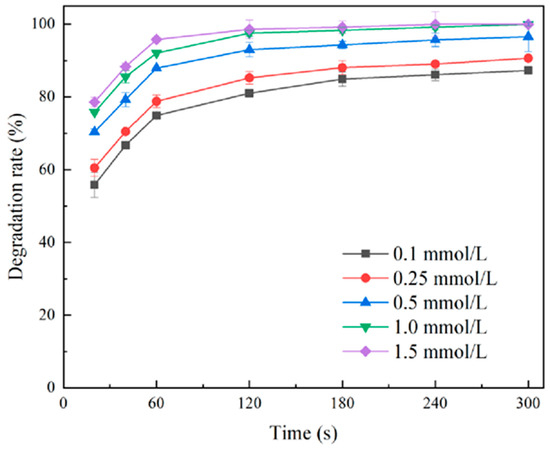
Figure 9.
Effect of ECG concentration on TC degradation by Lac-ECG system (tetracycline concentration: 50 mg/L; laccase concentration: 1 mg/mL; pH: 6.0; temperature: 25 °C; reaction time: 0–300 s; ECG concentration gradient: 0.1, 0.25, 0.5, 1.0, 1.5 mmol/L).
2.3. Antibacterial Activity of Tetracycline Degradation Products
As shown in Figure 10 and Figure 11, the degradation products obtained after 5 min of treatment with either the Lac-GTP or Lac-ECG system no longer exhibited antibacterial activity. This loss of antimicrobial activity is likely attributable to the destruction of the tetracycline’s molecular structure and is consistent with the findings of Suda et al. [44], who reported a complete loss of antibacterial activity in tetracycline after 1 h of treatment with a Lac-HBT system at pH 4.5 and 30 °C under 150 r/min shaking [44].
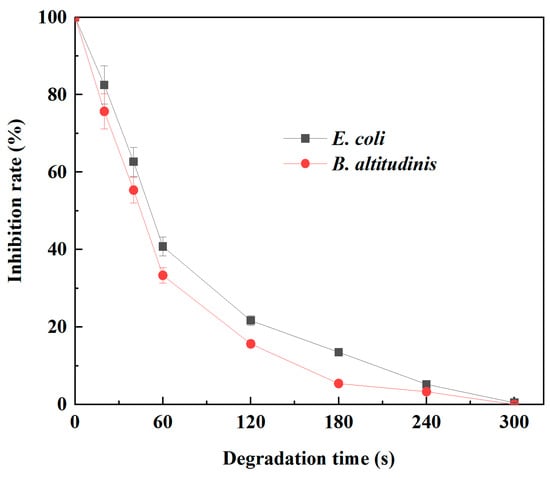
Figure 10.
Antibacterial activity of TC degradation products obtained after treatment with Lac-GTP system (degradation system: tetracycline concentration 50 mg/L, GTP concentration 1 mmol/L, laccase concentration 1 mg/mL, pH 6.0, temperature 25 °C, reaction time 0–300 s).
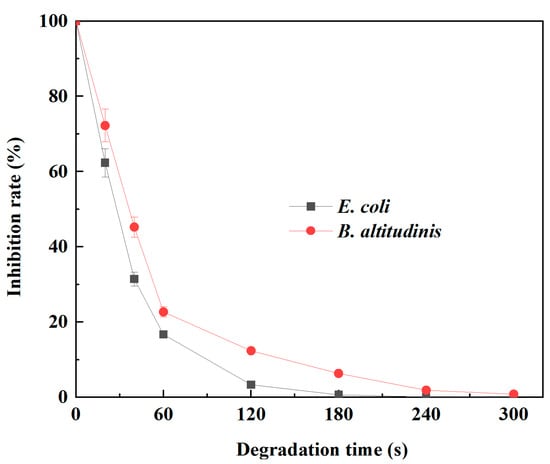
Figure 11.
Antibacterial activity of TC degradation products obtained after treatment with Lac-ECG system (degradation system: tetracycline concentration 50 mg/L, ECG concentration 1 mmol/L, laccase concentration 1 mg/mL, pH 6.0, temperature 25 °C, reaction time 0–300 s).
Table 2 summarizes existing studies on the treatment of various antibiotics by different laccase systems. Among them, Ding, H et al. [57] demonstrated that under the mediator syringaldehyde (SA), laccase derived from Trametes versicolor degraded 72.02 ± 0.59% of tetracycline (TC) within 15 min, had degraded more than 90% after 60 min, and achieved complete degradation after 3 h. Han Z W et al. [58] reported that the recombinant laccase from Bacillus amyloliquefaciens, assisted by the natural mediator acetosyringone (ACE), achieved a degradation efficiency of 86% of high-concentration TC within 1 h. Similarly, Ouyang B et al. [59] degraded 100% of TC within 6 h using laccase from Lysinibacillus fusiformis and ABTS as the mediator. In contrast, the antibacterial activity of degradation products was completely eliminated within 5 min in the Lac-GTP system and within 5.0 min in the Lac-ECG system developed in this study. Compared with the reported systems, the current approach demonstrates not only higher efficiency and complete degradation but also environmental friendliness.

Table 2.
Degradation of tetracycline by LMS.
3. Materials and Methods
3.1. Reagents and Chemicals
Laccase was kindly provided by the research group led by Prof. Wang Feng at Jiangsu University. The enzyme was produced by the fungal strain P. simulans F08 and purified via anion-exchange column chromatography. The specific activity of the purified laccase was determined to be 850.7 U/mg.
ABTS (98%, CAS: 30931-67-0), gallic acid (GA), epicatechin (EC), epigallocatechin gallate (EGCG), epigallocatechin (EGC), epicatechin gallate (ECG), gallocatechin (GC), and gallocatechin gallate (GCG) were purchased from Shanghai Macklin Biochemical Technology Co., Ltd, Shanghai, China. Tetracycline (95%, CAS: 60-54-8) was obtained from Shanghai Aladdin Biochemical Technology Co., Ltd, Shanghai, China. Other chemical reagents, including aluminum chloride, ferric chloride, and zinc sulfate, were supplied by Sinopharm Chemical Reagent Co., Ltd, Shanghai, China.
3.2. Extraction and Analysis of Polyphenols from Tea Residues
Preparation of Crude Tea Polyphenols: Tea leaves were first ground using a pulverizer and filtered through a 40-mesh sieve to obtain the extracted raw material. The sieved tea powder was wrapped in filter paper to form tea bags. Using 75% ethanol as the solvent, Soxhlet extraction was performed twice with a solid-to-liquid ratio of 1 g:20 mL. After extraction, the mixture was centrifuged, and the resulting supernatant was filtered through a 0.45 μm microporous membrane to remove impurities. Finally, the filtrate was concentrated and dried to obtain the final product, green tea polyphenol (GTP) powder. This method resulted in high extraction efficiency, and graded purification ensured the purity of the polyphenol components.
Purification of Tea Polyphenols: An appropriate amount of freeze-dried crude tea polyphenols was weighed and dissolved in distilled water. The solution was centrifuged at 4000 r/min for 20 min, and the supernatant was collected. A certain amount of acidic activated carbon was added, and the mixture was stirred on a magnetic stirrer for 30 min. After centrifugation, the supernatant was filtered through a 0.45 μm membrane and then concentrated and dried to obtain the purified tea polyphenol product.
The extracted tea polyphenol samples were analyzed using LC-MS, referencing and adapting the chromatographic and mass spectrometric conditions described by Kiehne A et al. [60].
3.3. Optimization of Parameters for Tetracycline Degradation by Lac–Mediator System
The Effect of the Natural Mediator Types on Tetracycline Degradation by Laccase: The reaction system had a total volume of 15 mL, containing 1.5 mL of a 500.0 mg/L tetracycline solution, 1.5 mL of a mediator solution, and an appropriate amount of a laccase solution. The mixture was brought to volume with a 0.1 mol/L phosphate buffer (pH 6.0). The final concentrations in the reaction system were 1 mmol/L for the mediator, 50 mg/L for the tetracycline, and 1 mg/mL for the laccase. The synthetic mediator ABTS was used as a positive control, and a system without any mediators served as a negative control. The reaction was carried out at 25 °C with shaking at 150 r/min. Samples of 2.5 mL were taken at 20 s, 40 s, 1 min, 2 min, 3 min, 4 min, and 5 min and immediately mixed with 5 mL of methanol to terminate the reaction.
The Effect of the Reaction Factors on Tetracycline Degradation by the Laccase–Mediator System: A total reaction volume of 5 mL was used, consisting of 0.5 mL of a freshly prepared 500.0 mg/L tetracycline solution, 0.5 mL of a mediator solution, a certain amount of a laccase solution, and a phosphate buffer (0.1 mol/L, pH 6.0) to adjust the final volume. After initiating the reaction, samples were taken at 20 s, 40 s, 1 min, 2 min, 3 min, 4 min, and 5 min and mixed with 10 mL of methanol to terminate the reaction. Using a controlled variable approach, the effects of different factors on the kinetics of tetracycline degradation were investigated. We tested factors including ranges of the pH (3.0–7.0), temperature (10.0–50.0 °C), laccase concentration (0.1–2.0 mg/mL), mediator concentration (0–2.0 mmol/L), and metal ion concentration (0.1–10.0 mmol/L).
The Effect of Different Tea Polyphenol Components on Tetracycline Degradation by Laccase: The reaction system had a total volume of 5 mL, consisting of 0.5 mL of a 500.0 mg/L tetracycline solution, 0.5 mL of a mediator solution containing different tea polyphenol components, a specified amount of a laccase solution, and a phosphate buffer (0.1 mol/L, pH 6.0) to bring the mixture to volume. After the reaction, 10 mL of methanol was added to terminate the process.
3.4. Rate of Consumption of Tetracycline
An HPLC analysis was performed under the following chromatographic conditions: The wavelength of the UV detector was set at 355 nm, and the mobile phase consisted of a phosphate buffer and acetonitrile at a ratio of 80:20 (v/v). The column temperature was maintained at 30 °C, the flow rate was 1 mL/min, and the injection volume was 20 μL. A C18 stainless steel column (5 μm, 4.6 mm × 250 mm) was used. The retention time and peak area of tetracycline were recorded.
A standard stock solution of tetracycline was serially diluted with distilled water to prepare working standard solutions at concentrations of 40, 20, 10, 5, and 1 mg/L. Each diluted solution was sonicated for degassing, brought to volume, and filtered through a 0.22 μm membrane before being transferred into 1.5 mL amber injection vials for analysis. Each concentration was injected in triplicate. A calibration curve was constructed by plotting the average peak area against the concentration, and a regression equation was derived for quantitative analysis of the tetracycline in the samples.
The tetracycline consumption rate was calculated using the following formula:
where C0 represents the initial concentration of tetracycline (mg/L) and Ct denotes the concentration of tetracycline (mg/L) after reaction time t.
Consumption rate (%) = (C0 − Ct)/C0 × 100%
Calculated contribution (%/µM) = (Degradation rate of LMS with single composition in GTP − Degradation rate of laccase alone)/(Concentration of single composition)
Sample Processing Procedure: The degradation culture broth was centrifuged at 4 °C and 8000 r/min for 10 min to collect the supernatant. Then, 4 mL of the supernatant was mixed thoroughly with 4 mL of a Na2EDTA–Mcllvaine buffer. The mixture was centrifuged again at 4 °C and 8000 r/min for 10 min. The resulting supernatant was filtered through a 0.22 μm membrane filter and transferred into a 1.5 mL amber injection vial for subsequent HPLC analysis.
3.5. Determination of Antibacterial Activity of Tetracycline Degradation Products
The antibacterial activity of products from different stages of tetracycline degradation was evaluated using the method described by Das et al. [61] with slight modifications. Preserved Gram-positive Bacillus subtilis and Gram-negative Escherichia coli strains were inoculated into a liquid LB medium (50 mL in 250 mL flasks) and activated through incubation at 37 °C with shaking at 200 r/min for 12–24 h.
An antibacterial assay was performed using the double-layer agar diffusion method: A thin base layer of a solid LB medium was first prepared in sterile Petri dishes and air-dried under a laminar flow hood to solidify it. Then, the activated bacterial suspension was mixed with a top layer of melted LB agar medium, and this mixture was poured over the base layer. After air-drying the medium again to solidify it, Oxford cups were placed on each plate. A volume of 200 µL of sample solutions from different degradation stages was added into each cup. The plates were incubated at 30 °C for 24 h, and the diameter of the inhibition zones was measured to evaluate the antibacterial activity.
3.6. Statistical Analyses
All experiments were performed in triplicate, and the data were expressed as mean ± standard deviation. A grouped analysis with two-way variance (ANOVA) followed by Tukey’s multiple comparison test was performed to analyze the difference in groups (p < 0.05).
4. Conclusions
This study systematically evaluated the effects of different natural mediators on the degradation of tetracycline by a laccase–mediator system (LMS). The results demonstrated that the Lac-GTP system, which used green tea polyphenols (GTPs) as the mediator, exhibited optimal degradation performance, achieving a degradation rate of 95.08% within 5 min and surpassing the efficiency of the synthetic mediator ABTS. Through optimizing the reaction conditions, the following optimal parameters were identified: a GTP concentration of 1 mmol/L, laccase concentration of 1 mg/mL, pH of 6.0, and temperature of 25 °C. In an investigation of the effects of metal ions, Ca2+, Mg2+, Cu2+, Fe3+, Fe2+, and Ni2+ were found to enhance tetracycline degradation by the Lac-GTP system, while Mn2+ and Hg2+ exerted inhibitory effects. Antibacterial activity assessments revealed that the degradation products of tetracycline treated with the Lac-GTP system completely lost their antimicrobial activity. Similarly, products degraded by the Lac-ECG system showed no inhibitory effects against Escherichia coli or Bacillus subtilis, indicating the effectiveness of the enzyme–mediator system in detoxifying tetracycline. As a major tea producer, China possesses abundant and widely distributed tea resources, providing a stable and low-cost raw material base for the extraction of GTPs. The GTPs used in this study are readily obtainable, significantly reducing their cost as a natural mediator and offering a substantial economic advantage over synthetic mediators such as ABTS. Furthermore, as natural products, GTPs exhibit both economic feasibility and environmental compatibility, avoiding the potential risks of secondary pollution and additional treatment costs that are associated with synthetic mediators. Based on the high efficiency, safety, and cost-effectiveness demonstrated by the Lac-GTP system in tetracycline degradation, we propose that this system can be applied to degrade other pollutants. Future research will focus on elucidating the structures and potential toxicity of intermediate degradation products, developing laccase immobilization techniques, and evaluating the efficacy of the Lac-GTP system in degrading other typical antibiotics. These efforts aim to further enhance the economic practicality of the system and establish a broad-spectrum, efficient laccase–natural mediator degradation technology. In conclusion, the Lac-GTP system demonstrates high efficiency and practical applicability in tetracycline degradation, showing promising potential for mitigating antibiotic pollution in the environment and providing a novel strategy for bioremediation.
Author Contributions
Conceptualization, L.X. and F.W.; methodology, G.G., S.H. and F.W.; software, H.X. and F.W.; validation, B.Z., H.X. and L.X.; formal analysis, L.X. and H.X.; investigation, H.X.; resources, S.H.; data curation, A.M.; writing—original draft preparation, L.X., S.Z. and F.W.; writing—review and editing, S.Z. and F.W.; visualization, J.Q. and A.M.; supervision, L.X. and F.W.; project administration, G.Z.; funding acquisition, S.H. All authors have read and agreed to the published version of the manuscript.
Funding
This work was supported by the National Natural Science Foundation of China (32370387, 32361143786).
Data Availability Statement
The data is available upon request.
Conflicts of Interest
The authors declare no conflicts of interest.
References
- Li, H.; Bei, Q.; Hassan, M.M.; Marimuthu, M.; Adade, S.Y.S.S.; Chen, Q.; Zareef, M. A Cu2+-modulated UCNPs@RBD sensor for sensitive detection of tetracyclines in food based on the spirolactam open-loop reaction. J. Food Compos. Anal. 2024, 133, 106374. [Google Scholar] [CrossRef]
- Leichtweis, J.; Vieira, Y.; Welter, N.; Silvestri, S.; Dotto, G.L.; Carissimi, E. A review of the occurrence, disposal, determination, toxicity and remediation technologies of the tetracycline antibiotic. Process Saf. Environ. 2022, 160, 25–40. [Google Scholar] [CrossRef]
- Amangelsin, Y.; Semenova, Y.; Dadar, M.; Aljofan, M.; Bjorklund, G. The impact of tetracycline pollution on the aquatic environment and removal strategies. Antibiotics 2023, 12, 440. [Google Scholar] [CrossRef]
- Xu, L.; Zhang, H.; Xiong, P.; Zhu, Q.Q.; Liao, C.Y.; Jiang, G.B. Occurrence, fate, and risk assessment of typical tetracycline antibiotics in the aquatic environment: A review. Sci. Total Environ. 2021, 753, 141975. [Google Scholar] [CrossRef]
- Ahmadijokani, F.; Molavi, H.; Tajahmadi, S.; Rezakazemi, M.; Amini, M.; Kamkar, M.; Rojas, O.J.; Arjmand, M. Coordination chemistry of metal–organic frameworks: Detection, adsorption, and photodegradation of tetracycline antibiotics and beyond. Coordin. Chem. Rev. 2022, 464, 214562. [Google Scholar] [CrossRef]
- Hu, Y.; Cheng, H. Health risk from veterinary antimicrobial use in China′s food animal production and its reduction. Environ. Pollut. 2016, 219, 993–997. [Google Scholar] [CrossRef]
- Zhang, Q.Q.; Ying, G.G.; Pan, C.G.; Liu, Y.-S.; Zhao, J.-L. Comprehensive evaluation of antibiotics emission and fate in the river basins of China: Source analysis, multimedia modeling, and linkage to bacterial resistance. Environ. Sci. Technol. 2015, 49, 6772–6782. [Google Scholar] [CrossRef] [PubMed]
- Gao, X.; Niu, J.; Wang, Y.; Ji, Y.; Zhang, Y. Solar photocatalytic abatement of tetracycline over phosphate oxoanion decorated Bi2WO6/polyimide composites. J. Hazard. Mater. 2021, 403, 123860. [Google Scholar] [CrossRef] [PubMed]
- Chen, X.; Ke, Y.; Zhu, Y.; Xu, M.; Chen, C.; Xie, S. Enrichment of tetracycline-degrading bacterial consortia: Microbial community succession and degradation characteristics and mechanism. J. Hazard. Mater. 2023, 448, 130984. [Google Scholar] [CrossRef]
- Dai, Y.; Peng, W.; Ji, Y.; Wei, J.; Che, J.; Huang, Y.; Huang, W.; Yang, W.; Xu, W. A self-powered photoelectrochemical aptasensor using 3D-carbon nitride and carbon-based metal-organic frameworks for high-sensitivity detection of tetracycline in milk and water. J. Food Sci. 2024, 89, 8022–8035. [Google Scholar] [CrossRef] [PubMed]
- Wei, Z.D.; Liu, J.Y.; Shangguan, W.F. A review on photocatalysis in antibiotic wastewater: Pollutant degradation and hydrogen production. Chin. J. Catal. 2020, 41, 1440–1450. [Google Scholar] [CrossRef]
- Philip, D.; Lakshmi, D.; Kumar, P.S.; Vo, D.V.N.; Kartik, A. Occurrence and removal of antibiotics from industrial wastewater. Environ. Chem. Lett. 2021, 19, 1477–1507. [Google Scholar] [CrossRef]
- Ouyang, Q.; Liu, Y.; Chen, Q.S.; Guo, Z.M.; Zhao, J.W.; Li, H.H.; Hu, W.W. Rapid and specific sensing of tetracycline in food using a novel upconversion aptasensor. Food Control 2017, 81, 156–163. [Google Scholar] [CrossRef]
- Zhang, Y.L.; Hassan, M.M.; Rong, Y.W.; Liu, R.; Li, H.H.; Ouyang, Q.; Chen, Q.S. An upconversion nanosensor for rapid and sensitive detection of tetracycline in food based on magnetic-field-assisted separation. Food Chem. 2022, 373, 131497. [Google Scholar] [CrossRef] [PubMed]
- Zhang, H.; Yu, Y.; Li, Y.; Zhang, C.; Zhang, W.L.; Wang, L.F.; Niu, L.H. A novel BC/g-C3N4 porous hydrogel carrier used in intimately coupled photocatalysis and biodegradation system for efficient removal of tetracycline hydrochloride in water. Chemosphere 2023, 317, 137888. [Google Scholar] [CrossRef]
- Liu, Z.; Yang, Y.; Liu, G.; Fang, J. Study on a novel immobilized microbe pellets constructed with Alcaligenes sp. R3 and its ability to remove tetracycline. J. Environ. Chem. Eng. 2023, 11, 109378. [Google Scholar] [CrossRef]
- Liu, L.; Yin, Q.; Hou, Y.; Ma, R.; Li, Y.; Wang, Z.Y.; Yang, G.G.; Liu, Y.; Wang, H.L. Fungus reduces tetracycline-resistant genes in manure treatment by predation of bacteria. Sci. Total Environ. 2024, 906, 167462. [Google Scholar] [CrossRef]
- Phoon, B.L.; Ong, C.C.; Saheed, M.S.M.; Show, P.L.; Chang, J.S.; Ling, T.C.; Lam, S.S.; Juan, J.C. Conventional and emerging technologies for removal of antibiotics from wastewater. J. Hazard. Mater. 2020, 400, 122961. [Google Scholar] [CrossRef] [PubMed]
- Li, S.J.; Chen, J.L.; Hu, S.W.; Wang, H.L.; Jiang, W.; Chen, X.B. Facile construction of novel Bi2WO6/Ta3N5 Z-scheme heterojunction nanofibers for efficient degradation of harmful pharmaceutical pollutants. Chem. Eng. J. 2020, 402, 126165. [Google Scholar] [CrossRef]
- Kang, X.X.; Jia, X.G.; Kang, Z.Y.; Zhang, Y.C.; Zhang, D.B.; Wei, J.L.; Guo, A.H.; Ge, M.; He, Z.X. Activation of peroxydisulfate by black fungus derived N-doped biochar for tetracycline degradation via non-radical dominated oxidation pathway. Surf. Interfaces 2022, 31, 102007. [Google Scholar] [CrossRef]
- Chen, X.L.; Yang, Y.Y.; Ke, Y.C.; Chen, C.; Xie, S.G. A comprehensive review on biodegradation of tetracyclines: Current research progress and prospect. Sci. Total Environ. 2022, 814, 152852. [Google Scholar] [CrossRef]
- He, X.; Kai, T.; Ding, P. Heterojunction photocatalysts for degradation of the tetracycline antibiotic: A review. Environ. Chem. Lett. 2021, 19, 4563–4601. [Google Scholar] [CrossRef]
- Li, R.; Zhou, T.Y.; Khan, A.; Ling, Z.M.; Sharma, M.; Feng, P.Y.; Ali, G.; Saif, I.; Wang, H.Y.; Li, X.K. Feed-additive of bioengineering strain with surface displayed laccase degrades sulfadiazine in broiler manure and maintains intestinal flora structure. J. Hazard. Mater. 2021, 406, 124440. [Google Scholar] [CrossRef]
- Gothwal, R.; Shashidhar, T. Antibiotic pollution in the environment: A review. Clean Soil Air Water 2015, 43, 479–489. [Google Scholar] [CrossRef]
- Tian, M.; He, X.M.; Feng, Y.Z.; Wang, W.T.; Chen, H.S.; Gong, M.; Liu, D.; Liu Clarke, J.H.; van Eerde, A. Pollution by antibiotics and antimicrobial resistance in livestock and poultry manure in China, and Countermeasures. Antibiotics 2021, 10, 539. [Google Scholar] [CrossRef] [PubMed]
- Gan, Z.Y.; Hu, X.T.; Xu, X.C.; Zhang, W.; Zou, X.B.; Shi, J.Y.; Zheng, K.Y.; Arslan, M. A portable test strip based on fluorescent europium-based metal-organic framework for rapid and visual detection of tetracycline in food samples. Food Chem. 2021, 354, 129501. [Google Scholar] [CrossRef]
- Liang, N.; Hu, X.T.; Zhang, X.N.; Li, W.T.; Guo, Z.A.; Huang, X.W.; Li, Z.H.; Zhang, R.J.; Shen, T.T.; Zou, X.B.; et al. Ratiometric sensing for ultratrace tetracycline using electrochemically active metal-organic frameworks as response signals. J. Agric. Food Chem. 2023, 71, 7584–7592. [Google Scholar] [CrossRef]
- Tan, H.; Kong, D.L.; Ma, Q.Y.; Li, Q.Q.; Zhou, Y.Q.; Jiang, X.; Wang, Z.Y.; Parales, R.E.; Ruan, Z.Y. Biodegradation of tetracycline antibiotics by the yeast strain Cutaneotrichosporon dermatis M503. Microorganisms 2022, 10, 565. [Google Scholar] [CrossRef] [PubMed]
- Li, Y.J.; Chen, H.B.; Wang, Y.Z.; Yang, Z.L.; Zhang, H.Y. Efficient biodegradation of chlortetracycline in high concentration from strong-acidity pharmaceutical residue with degrading fungi. J. Hazard. Mater. 2022, 424, 127671. [Google Scholar] [CrossRef] [PubMed]
- Deng, H.; Jin, Y.; Yan, B.J.; Jiang, Y.; Yang, S.G.; Song, T.H. Degradation of tetracycline by heat/peroxymonosulfate and ultrasound/peroxymonosulfate systems: Performance and kinetics. Water Sci. Technol. 2024, 89, 421–433. [Google Scholar] [CrossRef]
- Zhao, L.; Dong, Y.H.; Wang, H. Residues of veterinary antibiotics in manures from feedlot livestock in eight provinces of China. Sci. Total Environ. 2010, 408, 1069–1075. [Google Scholar] [CrossRef]
- Liang, N.; Hu, X.; Li, W.; Wang, Y.; Guo, Z.; Huang, X.; Li, Z.; Zhang, X.; Zhang, J.; Xiao, J. A dual-signal fluorescent sensor based on MoS2 and CdTe quantum dots for tetracycline detection in milk. Food Chem. 2022, 378, 132076. [Google Scholar] [CrossRef]
- Lin, Y.C.; Zhuang, G.L.; Tasi, P.F.; Tseng, H.H. Removal of protein, histological dye and tetracycline from simulated bioindustrial wastewater with a dual pore size PPSU membrane. J. Hazard. Mater. 2022, 431, 128525. [Google Scholar] [CrossRef]
- Yang, G.; Zhang, G.; Wang, H. Current state of sludge production, management, treatment and disposal in China. Water Res. 2015, 78, 60–73. [Google Scholar] [CrossRef]
- Shi, B.Q.; Zhang, X.N.; Li, W.T.; Liang, N.N.; Hu, X.T.; Xiao, J.B.; Wang, D.Y.; Zou, X.B.; Shi, J.Y. An intrinsic dual-emitting fluorescence sensing toward tetracycline with self-calibration model based on luminescent lanthanide-functionalized metal-organic frameworks. Food Chem. 2023, 400, 133995. [Google Scholar] [CrossRef] [PubMed]
- Kang, J.; Tang, Y.W.; Wang, M.; Jin, C.Y.; Liu, J.Y.; Li, S.Y.; Li, Z.L.; Zhu, J.W. The enhanced peroxymonosulfate-assisted photocatalytic degradation of tetracycline under visible light by g-C3N4/Na-BiVO4 heterojunction catalyst and its mechanism. J. Environ. Chem. Eng. 2021, 9, 105524. [Google Scholar] [CrossRef]
- Saravanan, A.; Senthil Kumar, P.; Vo, D.-V.N.; Jeevanantham, S.; Karishma, S.; Yaashikaa, P.R. A review on catalytic-enzyme degradation of toxic environmental pollutants: Microbial enzymes. J. Hazard. Mater. 2021, 419, 126451. [Google Scholar] [CrossRef] [PubMed]
- Wang, X.T.; Meng, F.P.; Zhang, B.; Xia, Y.F. Elimination of tetracyclines in seawater by laccase-mediator system. Chemosphere 2023, 333, 138916. [Google Scholar] [CrossRef]
- Lassouane, F.; Aït-Amar, H.; Amrani, S.; Rodriguez-Couto, S. A promising laccase immobilization approach for Bisphenol A removal from aqueous solutions. Bioresour. Technol. 2019, 271, 360–367. [Google Scholar] [CrossRef]
- Al-Dhabi, N.A.; Esmail, G.A.; Arasu, M.V. Effective degradation of tetracycline by manganese peroxidase producing Bacillus velezensis strain Al-Dhabi 140 from Saudi Arabia using fibrous-bed reactor. Chemosphere 2021, 268, 128726. [Google Scholar] [CrossRef]
- Wang, F.; Wang, M.T.; Wang, M.M.; Xu, L.; Qian, J.Y.; Guan, G.Q.; Xu, B.G. Clarification of sugarcane juice catalyzed by magnetic immobilized laccase intensified by alternating magnetic field. Foods 2025, 14, 444. [Google Scholar] [CrossRef]
- Shi, L.L.; Yu, H.B.; Dong, T.B.; Kong, W.; Ke, M.; Ma, F.Y.; Zhang, X.Y. Biochemical and molecular characterization of a novel laccase from selective lignin-degrading white-rot fungus Echinodontium taxodii 2538. Process Biochem. 2014, 49, 1097–1106. [Google Scholar] [CrossRef]
- Nazar, M.; Xu, Q.; Zahoor; Ullah, M.W.; Khan, N.A.; Iqbal, B.; Zhu, D.C. Integrated laccase delignification with improved lignocellulose recalcitrance for enhancing enzymatic saccharification of ensiled rice straw. Ind. Crop. Prod. 2023, 202, 116987. [Google Scholar] [CrossRef]
- Suda, T.; Hata, T.; Kawai, S.; Okamura, H.; Nishida, T. Treatment of tetracycline antibiotics by laccase in the presence of 1-hydroxybenzotriazole. Bioresour. Technol. 2012, 103, 498–501. [Google Scholar] [CrossRef]
- Lou, Q.; Wu, Y.X.; Ding, H.J.; Zhang, B.H.; Zhang, W.H.; Zhang, Y.; Han, L.; Liu, M.T.; He, T.; Zhong, J.Y. Degradation of sulfonamides in aquaculture wastewater by laccase-syringaldehyde mediator system: Response surface optimization, degradation kinetics, and degradation pathway. J. Hazard. Mater. 2022, 432, 128647. [Google Scholar] [CrossRef]
- Jinga, L.I.; Tudose, M.; Ionita, P. Laccase-TEMPO as an efficient system for doxorubicin removal from wastewaters. Int. J. Environ. Res. Public Health 2022, 19, 6645. [Google Scholar] [CrossRef] [PubMed]
- Zhao, T.T.; Li, C.; Wang, S.; Song, X.Q. Green tea (Camellia sinensis): A review of its phytochemistry, pharmacology, and toxicology. Molecules 2022, 27, 3909. [Google Scholar] [CrossRef] [PubMed]
- Kaur, P.; Gandhi, S.; Sharma, R.; Kaur, L.; Pal, M.; Deswal, G.; Chopra, B.; Grewal, A.S.; Dhingra, A.K. Extraction, phytochemistry & pharmacological potential of Camellia sinensis: A comprehensive review. Nat. Prod. J. 2024, 14, 21. [Google Scholar] [CrossRef]
- Jiao, Y.J.; Cai, M.; Zhang, X.; Feng, Z.; Zhang, Q.Z.; Li, L.L.; Jin, G.; Fan, S.S.; Lu, L.T. Impact of spreading time on flavor quality in Duyun Maojian summer green tea. LWT Food Sci. Technol. 2024, 214, 117103. [Google Scholar] [CrossRef]
- Tao, M.; Guo, W.L.; Liang, J.; Liu, Z.Q. Unraveling the key cooked off-flavor compounds in thermally sterilized green tea beverages, and masking effect of tea raw material baking. Food Chem. 2025, 464, 141671. [Google Scholar] [CrossRef]
- Nguyen, L.N.; Hai, F.I.; Kang, J.; Leusch, F.D.L.; Roddick, F.; Magram, S.F.; Price, W.E.; Nghiem, L.D. Enhancement of trace organic contaminant degradation by crude enzyme extract from Trametes versicolor culture: Effect of mediator type and concentration. J. Taiwan Inst. Chem. E 2014, 45, 1855–1862. [Google Scholar] [CrossRef]
- Wen, X.; Jia, Y.; Li, J. Enzymatic degradation of tetracycline and oxytetracycline by crude manganese peroxidase prepared from Phanerochaete chrysosporium. J. Hazard. Mater. 2010, 177, 924–928. [Google Scholar] [CrossRef]
- Cvancarová, M.; Moeder, M.; Filipová, A.; Cajthaml, T. Biotransformation of fluoroquinolone antibiotics by ligninolytic fungi—Metabolites, enzymes and residual antibacterial activity. Chemosphere 2015, 136, 311–320. [Google Scholar] [CrossRef] [PubMed]
- Lopes, L.S.; Vieira, N.; da Luz, J.M.R.; de Cássia, S.; Silva, M.; Cardoso, W.S.; Kasuya, M.C.M. Production of fungal enzymes in Macaúba Coconut and enzymatic degradation of textile dye. Biocatal. Agric. Biotechnol. 2020, 26, 101651. [Google Scholar] [CrossRef]
- Weng, S.S.; Liu, S.M.; Lai, H.T. Application parameters of laccase-mediator systems for treatment of sulfonamide antibiotics. Bioresour. Technol. 2013, 141, 152–159. [Google Scholar] [CrossRef]
- Shams, S.; Ahmad, W.; Memon, H.; Wei, Y.; Yuan, Q.P.; Liang, H. Facile synthesis of laccase mimic Cu/H3BTC MOF for efficient dye degradation and detection of phenolic pollutants. RSC Adv. 2019, 9, 40845–40854. [Google Scholar] [CrossRef] [PubMed]
- Ding, H.J.; Wu, Y.X.; Zou, B.C.; Lou, Q.; Zhang, W.H.; Zhong, J.Y.; Lu, L.; Dai, G.F. Simultaneous removal and degradation characteristics of sulfonamide, tetracycline, and quinolone antibiotics by laccase-mediated oxidation coupled with soil adsorption. J. Hazard. Mater. 2016, 307, 350–358. [Google Scholar] [CrossRef]
- Han, Z.W.; Wang, H.R.; Zheng, J.; Wang, S.S.; Yu, S.Y.; Lu, L. Ultrafast synthesis of laccase-copper phosphate hybrid nanoflowers for efficient degradation of tetracycline antibiotics. Environ. Res. 2023, 216, 114690. [Google Scholar] [CrossRef]
- Ouyang, B.B.; Xu, W.; Zhang, W.L.; Guang, C.; Mu, W.M. Efficient removal of sulfonamides and tetracyclines residues by the laccase-mediator system employing a novel laccase from Lysinibacillus fusiformis. J. Environ. Chem. Eng. 2022, 10, 108809. [Google Scholar] [CrossRef]
- Kiehne, A.; Engelhardt, U.H. Thermospray-LC-MS analysis of various groups of polyphenols in tea. I. Catechins, flavonol O-glycosides and flavone C-glycosides. Z. Lebensm.-Unters. Forsch. 1996, 202, 48–54. [Google Scholar] [CrossRef]
- Das, A.; Datta, S.; Mukherjee, S.; Bose, S.; Ghosh, S.; Dhar, P. Evaluation of antioxidative, antibacterial and probiotic growth stimulatory activities of Sesamum indicum honey containing phenolic compounds and lignans. LWT Food Sci. Technol. 2015, 61, 244–250. [Google Scholar] [CrossRef]
Disclaimer/Publisher’s Note: The statements, opinions and data contained in all publications are solely those of the individual author(s) and contributor(s) and not of MDPI and/or the editor(s). MDPI and/or the editor(s) disclaim responsibility for any injury to people or property resulting from any ideas, methods, instructions or products referred to in the content. |
© 2025 by the authors. Licensee MDPI, Basel, Switzerland. This article is an open access article distributed under the terms and conditions of the Creative Commons Attribution (CC BY) license (https://creativecommons.org/licenses/by/4.0/).